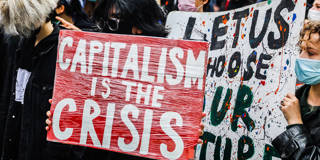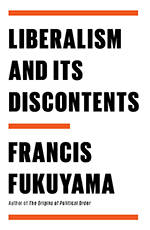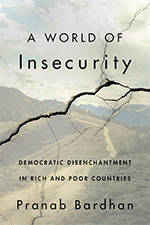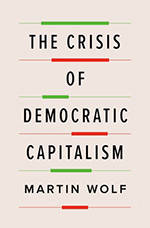
The Sense of an Ending
Mar 10, 2023
Three recent books combine theoretical sophistication and historical method in ways that enable us to rethink majority rule and thus re-imagine the future of democracy. And the most searching of the three calls into question whether that future is compatible with capitalism as we have come to know it.
Martin Wolf, The Crisis of Democratic Capitalism (Penguin Press, 2023)
Francis Fukuyama, Liberalism and Its Discontents (Farrar, Straus and Giroux, 2022)
Pranab Bardhan, A World of Insecurity: Democratic Disenchantment in Rich and Poor Countries (Harvard University Press, 2022)
NEW YORK – The great bourgeois revolutionaries who invented modernity, from John Milton to James Madison to Abraham Lincoln, didn’t know they were laying the foundations of capitalism. To be sure, they understood that a money economy – a social system animated by the impending commodification of everything, even labor power – was laying waste to inherited, mostly parochial hierarchies, redefining liberty and making the idea of equality a live option. But they would be appalled by a global civilization in which the market is the measure of all things, where everyone finally has a price and each must buy the right not to die. No one would be more horrified than Adam Smith, the philosopher-king of the Scottish Enlightenment and the first court poet of bourgeois society.
The leading intellectuals of our time, by contrast, know that capitalism as most of us have experienced it is now in its death throes, and that what comes after strongly resembles the mode of production most people call socialism. They know such things because Karl Marx – like Hegel an admirer of Smith – taught them how to understand modernity as that stage of civilization in which commerce would make constant change, transition itself, an everyday fact of life: “All that is solid melts into air,” as the Communist Manifesto put it. Just as capitalism superseded feudalism, so capitalism would somehow, some day, give way to something else, because neither its spirit nor its social content reflected fixed properties of human nature.1
Meanwhile, because the avowed Marxists, at least firebrands like Lenin and Mao, have taught today’s leading intellectuals that the transition from capitalism to socialism would require a revolution, they have learned to fear what seems, especially now, to be an impending if not inevitable future. Their consequent silence on the subject explains why it’s easier for the rest of us to imagine the end of the world than to plan on, and prepare for, the end of capitalism.
But Marx himself wasn’t so sure that capitalism would end with the overthrow of the state, the dictatorship of the proletariat, or even armed struggle. As he saw it, “the abolition of capitalist property from within the bounds of capitalist production itself” was the obvious result of corporate capitalism, founded on the twin pillars of joint-stock companies and modern credit, both of which separated ownership and control of private property. A new “socialized mode of production” was already nascent.
In the United States nowadays, Republicans seem to agree: “woke” corporations and “traitorous” Democrats are imposing socialism – a “radical left” agenda – on the real America, which doesn’t cotton to welfare, public health and education, abortion, gay rights and same-sex marriage, gender pluralism, environmental protection, immigrants, or gun control. All of these policies are of, by, and for the snotty coastal elites and native-born people of color in the cities.
So, as the end of capitalism and the prospect of socialism have obtruded on normal, everyday political discourse, our very own transition question has become more or less unavoidable. Leading intellectuals have responded accordingly, by explaining – or trying to – where the transition might lead and what both the disintegrating past and the impending future have to teach us.
OLD REPUBLICANS
The situation confronting today’s intellectuals is, then, comparable to that which Madison faced in the spring of 1786, when he was reckoning with both the surprising success and probable demise of the American Revolution. Since 1774, when the Continental Congress instructed the colonies to start writing constitutions, the revolution had been animated by local assemblies, town meetings, state militias, and a torrent of constitutional drafts that produced radical experiments like Pennsylvania’s unicameral legislature, a body elected by mere taxpayers (white males only, of course) rather than property-owning freeholders.
The Articles of Confederation were a diplomatic compact of sovereign states so conceived, not a blueprint for a modern nation-state, because there was no central authority that could demand compliance with its policies (the Continental Congress had no monopoly on the force of arms) or overrule laws enacted under the new constitutions. Nor had anyone conjured an identity for “Americans,” a body politic which transcended local boundaries. The States were not yet United.
By the mid-1780s, this dispersal of power among the states had devolved into what Thomas Jefferson called an “elective despotism,” or what Madison perceived, from a more distant intellectual remove, as a dearth of republican legitimacy, that is, a lack of justification for majority rule. His question had become: what, exactly, is the point of insisting on the sovereignty of the people, as against the state or the government (whether embodied in a benevolent monarch, a scrupulous minister, or a duly elected parliament), if the laws they enacted were as destructive of natural right as any tyrant’s arbitrary command?
The two great innovations of the revolution thus far were this unprecedented insistence on the locus of legitimate power “out of doors” and the correlative notion that liberty was impossible in the absence of equality. But what if equality permitted, or even promoted, the tyranny of majorities?
Madison knew that the traditional resources of the statesman – prudence, custom, and reason – offered no answers, so he ransacked the thin, scattered history of republican governments, to see if earlier experiments composed a usable past. To his astonishment, they did not. Every previous republic had tried and failed to escape the corrosive social effects of historical time embodied, literally and metaphorically, in “commerce,” which typically manifested as class divisions and conflict.
At that point, the rights of persons and the rights of property, what Madison called “the two Cardinal objects of Government,” had become the terms of an either/or choice, and the outcome was invariably decided in favor of property by property owners. In every case, “the poor were sacrificed to the rich,” Madison lamented, putting an end to popular government.
How could a republic avoid this fate? Madison’s solution was to enlist historical time – “commerce,” development, and class division and conflict – in the creation and stabilization of republican government, by “extending the sphere” of the polity to take in more diverse populations and interests, and by devising a constitutional structure that made the rights of persons and the rights of property the terms of an undecidable choice. He modified the sovereignty of the people – he divided them against themselves – in order to postpone or prolong the formation of majorities, not to thwart them.
In doing so, Madison made equality the fundamental condition of liberty. It was a radical departure from received wisdom, and it made for the kind of change that was so revolutionary that Americans still doubt and debate it more than two centuries later, almost always by invoking “the founders,” whether reverently or ruefully.
OUR MADISONIAN MOMENT
Martin Wolf, Francis Fukuyama, and Pranab Bardhan have put themselves in Madison’s place, by publishing manifestos that combine theoretical sophistication and historical method in ways that enable us to rethink majority rule and thus reimagine the future of democracy. All three acknowledge that the parasite called neoliberalism has just about killed off its capitalist host by spawning authoritarian alternatives with global appeal. And all three adopt the unfinished American experiment as the template for the new thinking they propose. Each quotes Lincoln to define democracy, and two actually cite Madison to address the possibility of “civic” rather than ethnic nationalism in managing the diversity that inevitably follows from economic globalization.
But Wolf goes much further than Fukuyama and Bardhan, not so much auditioning for Madison’s role as reprising it. His book offers both a brilliant summary of the received wisdom concerning the troubled relationship between democratic politics and free markets – a difficult marriage, as he puts it – and a radical departure that combines unfettered imagination and extraordinary erudition to summon a different, less contentious kind of partnership

Fukuyama, who identifies as a right-wing Marxist in the tradition of the Russian-born French philosopher Alexandre Kojève, has written the least ambitious of the manifestos. He aims merely to restate and clarify the claims of “classical” liberalism, then test them against recent criticisms from the left and the right. The result is a “fair and balanced” treatment of the doctrinal triangulation, but one which leaves the reader wondering for most of the book where the author stands.
Indeed, it is only in the book’s last two chapters that the “need to restore liberalism’s normative framework, including its approach to rationality and cognition” is announced as the real agenda. The key word here is “restore.” Fukuyama seems to think that, when compared as theories of governance, the alternatives residing in the various critiques of liberalism just don’t measure up: they’re intellectually inferior as well as practically unworkable – and obviously so. But he acknowledges that the right-wing, ethno-nationalist, religiously inspired alternatives have actual or potential majorities waiting on their enactment.
By this accounting, the right learned its new know-nothing parochialism from the radical left’s critique of liberalism’s “primordial individualism,” from its valorization of particular group experience as against Enlightenment universalism, and from its mistrust of the scientific method that both forms and reflects modern liberal rationality. The middle ground, where classical liberalism survives – barely – as paleo-conservatism, has been hollowed out by intellectual incursions from the left and the right. And even here, only the “traditionalist” variant of conservatism, represented by the likes of Adrian Vermeule of Harvard Law School, the self-exiled (to Hungary) conservative polemicist Rod Dreher, and Patrick Deneen of Notre Dame, seems to be intellectually alive. Fukuyama won’t let us mistake classical liberalism for modern democracy, but he insists that by enabling free markets, it authorizes autonomous individuals and thus the possibility of a politics informed by equality and the consent of the governed.
Fukuyama’s invocation of Lincoln tellingly concludes his discussion of these “traditionalists,” Vermeule, Dreher, and Deneen, in keeping with the suspicion he shares with them of majority rule as the measure of legitimate governance, and the doubts he shares with them about the strictly utilitarian logic of neoliberalism. Lincoln rejected Stephen A. Douglas’s program of “popular sovereignty,” which allowed the majority of settlers in the federal territories to decide whether slavery would be lawful there, for two reasons. First, it excluded most of the heirs to that frontier legacy of free land, a vast population composed of generations to come. Second, it violated what Fukuyama would call the normative, regulative principle at the heart of the liberal American experiment, expressed in the imperative phrase from the Declaration of Independence: “all men are created equal.”
Lincoln insisted that the South did not have the right to do what is wrong – to enslave human beings by making property of them – regardless of the majorities it could muster in the electorate, the Senate, or the Supreme Court. Fukuyama likewise insists that neither the utopian neoliberals nor the right-wing populists, the true believers in the church of capitalism, have the right to do what is wrong – to suspend the individualism, egalitarianism, universalism, and rationalism inherent in the liberal tradition – even if they represent solid majorities.
A VIEW FROM BELOW
Bardhan is less certain of that legacy, partly because he studies those parts of the world, particularly South Asia, where liberalism was never a birthright because it arrived as a foreign import, a dimension of colonial rule. He is also much more attuned than Fukuyama to the possibility that the centrifugal social logic of classical liberalism fueled the nihilism common to neoliberalism and authoritarian populism. An economist by training and occupation, Bardhan is more interested than Fukuyama the political theorist in the politics of the impending transition from capitalism to social democracy, and more cognizant than Wolf the economic journalist of how inequality registers in populist revolts as cultural resentment.

The great virtue of Bardhan’s approach is that this transition appears as an untidy, ongoing, even measurable process, rather than a distant prospect to be outlined, for now, as a theoretical model. Half of the book is devoted to close scrutiny of the social-democratic possibilities and policies that already reside in and flow from existing practices, in both rich and poor countries (Bardhan, a professor emeritus at the University of California, Berkeley, was chief editor of the Journal of Development Economics and is an esteemed authority on the political economy of India). In this sense, it usefully complements Fukuyama’s skeletal intellectual anatomy of liberalism; for it proposes that liberalism’s ethical principles – its normative claims – are still as palpable today in our present historical circumstances, in the political ruins we call neoliberalism and populism, as they were at their origin in the seventeenth century.
Bardhan’s most intriguing chapter, “The Slippery Slope of Majoritarianism,” is also the shortest: at only eight pages, it could pass for a footnote. But it’s here that he makes the two claims that announce the book’s originality. On one hand, he suggests that the origins of democracy lie in a welter of competition, either between elites and subaltern social strata or among elites themselves. Both prototypes play out as ideological struggle over civil rights, as per Madison’s “Cardinal objects of Government,” because each party to the resulting social contract had enough leverage to threaten the others’ standing. On the other hand, he fleshes out the idea that such competition has been, and can continue to be, ethnic and/or religious, that is, cultural, both at its source and in its expressions, whether in rich or poor countries. This idea can be read as a corrective or a supplement to Wolf’s emphasis on the broadly economic causes of subaltern resentment and revolt, which have led us to the brink of democracy’s global extinction by majoritarian means.
PERSONS AND PROPERTY
The Crisis of Democratic Capitalism is the most searching of the three books – or any other study of our current condition – because it is the most pointed in asking a contemporary version of Madison’s question, and the most ecumenical in canvassing possible responses that are consistent with the freedoms specific to modern market societies. Wolf’s version of the question could be paraphrased as follows: If markets (“commerce”) are essential to both liberty and equality as we have come to understand them since the advent of capitalism, and if neoliberalism has reduced liberty to an individual’s license to profit from the exploitation of anything, thus blocking the once-broad avenues to equality, what kind of markets would reconcile the rights of property and the rights of persons, and, in so doing, serve the cause of democracy?

The assumption here is of course that majorities are not the sole measure of democracy. As Madison and Lincoln often insisted, only the consent of the governed – their willingness to abide by the laws they have participated in making, directly or by virtue of their citizenship – can ensure the legitimacy required by the modern republican standard of equality before the law. Otherwise, the states that imposed the terrorist yet constitutional and majoritarian Jim Crow regime on Black people in the post-bellum South could be defined as democratic polities.
The age of democratic capitalism, according to Wolf, commenced about 1870 and ended around 1980. By his accounting, then, capitalism has continued to develop since Ronald Reagan and Margaret Thatcher dismantled the postwar Keynesian consensus in the West and Mikhail Gorbachev dismantled communism in the East, but democracy has stalled. In fact, capitalism in the West has by now devolved to a baroque, rentier stage (Wolf abjures the label of neoliberalism) recalling the grotesque caricatures of the late nineteenth century, when bloated monopolists were rendered as vampires or cephalopods, all teeth or tentacles. Meanwhile, the growth of democracy has been stunted by the rise of state/authoritarian capitalism in Eastern Europe and Asia (particularly in China), and of angry, ethno-nationalist populism in Britain and the US.
As with Bardhan’s book, the bulk of The Crisis of Democratic Capitalism is devoted to a programmatic outline of ways to reinvent the system, not to “restore” some lost golden age, or to reinstate the first principles of free enterprise, or otherwise to treat the past as prologue to an acceptable, inhabitable future. Wolf is more ambitious than that, and, in view of the actually existing crises he charts so relentlessly and meticulously, from climate change to the con game we know as the banking system, he has no choice. But he cloaks his radical ideas in the persona and language of a centrist, buttoned-down journalist out to save capitalism from its excesses, not to promote revolutionary change.
No one should be fooled by the sheep’s clothing. Like Mervyn King, the former governor of the Bank of England, and Willem Buiter, a former chief economist at Citigroup and currently one of the world’s leading authorities on central banking, Wolf thinks that private control of bank assets is an absurdity. Magnified by “elite malfeasance” in every other sector of the globalized economy, this is warrant enough to complete the socialization of private property foretold in the formation of joint-stock companies that separated ownership and control of corporate capital. In effect, he implores us to act on Marx’s insight into the revolutionary possibilities of corporate capitalism – that is, into the “socialized mode of production” it made possible, and now necessary, as the solution to a worldwide crisis of democracy.
This conclusion will no doubt seem ridiculous to most readers of The Financial Times, where Wolf has presided as an associate editor for three decades, sometimes sounding like the cheerleader-in-chief for globalization. But consider his summary of our situation:
“The insecurity that laissez-faire capitalism generates for the great majority who own few assets and are unable to insure or protect themselves against such obvious misfortunes as the unexpected loss of a job or incapacitating illness, is ultimately incompatible with democracy. That is what Western countries had learned by the early to mid-twentieth century. It is what they have learned again over the last four decades. Only autocracy, plutocracy, or some combination of the two is likely to thrive in an economy that generates such insecurity and a polity that shows such indifference.”
Moreover, The Crisis of Democratic Capitalism offers a vision of the future that is radical because it gives priority to democracy (the rights of persons) over capitalism (the rights of property). And yet it is also practical, because it enlists markets in the recreation of citizenship. Wolf’s notion of citizenship carries echoes of the classical republican (Aristotelian) kind, because it entails a “positive” definition of freedom: liberty consists not merely in the absence of external constraint, as per modern liberal (utilitarian) ideals of “negative” freedom, but in access to the resources necessary for a “fulfilled life.” Accordingly, he posits “an economy that allows citizens to flourish in this way” as the condition of equality, and thus democracy.
Wolf refuses to call what comes of this vision socialism, because, like Bardhan and presumably Fukuyama, he still equates socialism with Soviet-style central planning and statist command of all resources. No matter. Call it peas and carrots: it still rhymes with hope rooted in the knowledge that the social, economic, and intellectual changes we desperately need to solve the crisis that now besets us are already underway, already within our grasp. This book is a record of them. The Crisis of Democratic Capitalism never says that the choice before us is either socialism or barbarism. But it comes close enough to suggest that the moderate Martin Wolf has become just the radical we need to address our own transition question.
Neglect the insights of women, particularly in economics, and society suffers. At PS’s next virtual event, What Economics Is Missing, Minouche Shafik, Dani Rodrik, Vera Songwe, and others will debate how to create the conditions for achieving genuine inclusivity in economics.

JAMES LIVINGSTON
James Livingston, Professor of History at Rutgers University, is the author of six books, including Origins of the Federal Reserve System: Money, Class, and Corporate Capitalism, 1890-1913 (Cornell University Press, 1986), and the forthcoming The Intellectual Earthquake: How Pragmatism Changed the World, 1898-2008 (University of Chicago Press).



